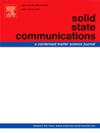A comprehensive theoretical analysis of Cs2KGaX6 (X = Cl, Br, I): For green energy solutions
IF 2.1
4区 物理与天体物理
Q3 PHYSICS, CONDENSED MATTER
引用次数: 0
Abstract
Researchers have identified double perovskites as promising materials for thermoelectric and optoelectronic technologies, owing to their versatility in energy-related applications. This research is mostly about the compounds Cs2KGaX6 [X = Cl, Br, I]. It uses advanced computer programs called Wien2K and BoltzTraP to investigate their structure, electronic, optical, and thermoelectric properties. Structural analysis confirms the stability of these compounds through energy versus volume curve evaluations. The calculated band gaps for Cs2KGaCl6, Cs2KGaBr6, and Cs2KGaI6 are 4.938 eV, 3.449 eV, and 2.924 eV, respectively. These values indicate that the materials can absorb light in both the visible and ultraviolet regions. The study of optical properties shows that Cs2KGaX6 [X = Cl, Br, I] has strong light absorption, high electrical conductivity, interesting dielectric constants, optical reflectivity, and interesting refractive indices. These properties make it a great choice for photovoltaic uses. We meticulously evaluated the transport properties, including the Seebeck coefficient, as well as the thermal and electrical conductivities. The results highlight the strong potential of these materials for thermoelectric generators. The Cs2KGaX6 [X = Cl, Br, I] compounds demonstrate exceptional properties, solidifying their viability as sustainable energy materials, particularly for photovoltaic and thermoelectric applications.
绿色能源溶液Cs2KGaX6 (X = Cl, Br, I)的综合理论分析
由于双钙钛矿在能源相关应用中的多功能性,研究人员已经确定双钙钛矿是热电和光电子技术的有前途的材料。本文主要研究化合物Cs2KGaX6 [X = Cl, Br, I]。它使用名为Wien2K和BoltzTraP的先进计算机程序来研究它们的结构、电子、光学和热电特性。结构分析通过能量与体积曲线评价证实了这些化合物的稳定性。计算得到Cs2KGaCl6、Cs2KGaBr6和Cs2KGaI6的带隙分别为4.938 eV、3.449 eV和2.924 eV。这些数值表明,该材料既能吸收可见光,也能吸收紫外线。光学性质研究表明,Cs2KGaX6 [X = Cl, Br, I]具有强光吸收、高导电性、有趣的介电常数、光学反射率和折射率。这些特性使其成为光伏应用的绝佳选择。我们仔细地评估了输运性质,包括塞贝克系数,以及导热性和导电性。结果突出了这些材料在热电发电机方面的强大潜力。Cs2KGaX6 [X = Cl, Br, I]化合物表现出优异的性能,巩固了它们作为可持续能源材料的可行性,特别是在光伏和热电应用方面。
本文章由计算机程序翻译,如有差异,请以英文原文为准。
求助全文
约1分钟内获得全文
求助全文
来源期刊

Solid State Communications
物理-物理:凝聚态物理
CiteScore
3.40
自引率
4.80%
发文量
287
审稿时长
51 days
期刊介绍:
Solid State Communications is an international medium for the publication of short communications and original research articles on significant developments in condensed matter science, giving scientists immediate access to important, recently completed work. The journal publishes original experimental and theoretical research on the physical and chemical properties of solids and other condensed systems and also on their preparation. The submission of manuscripts reporting research on the basic physics of materials science and devices, as well as of state-of-the-art microstructures and nanostructures, is encouraged.
A coherent quantitative treatment emphasizing new physics is expected rather than a simple accumulation of experimental data. Consistent with these aims, the short communications should be kept concise and short, usually not longer than six printed pages. The number of figures and tables should also be kept to a minimum. Solid State Communications now also welcomes original research articles without length restrictions.
The Fast-Track section of Solid State Communications is the venue for very rapid publication of short communications on significant developments in condensed matter science. The goal is to offer the broad condensed matter community quick and immediate access to publish recently completed papers in research areas that are rapidly evolving and in which there are developments with great potential impact.
 求助内容:
求助内容: 应助结果提醒方式:
应助结果提醒方式:


